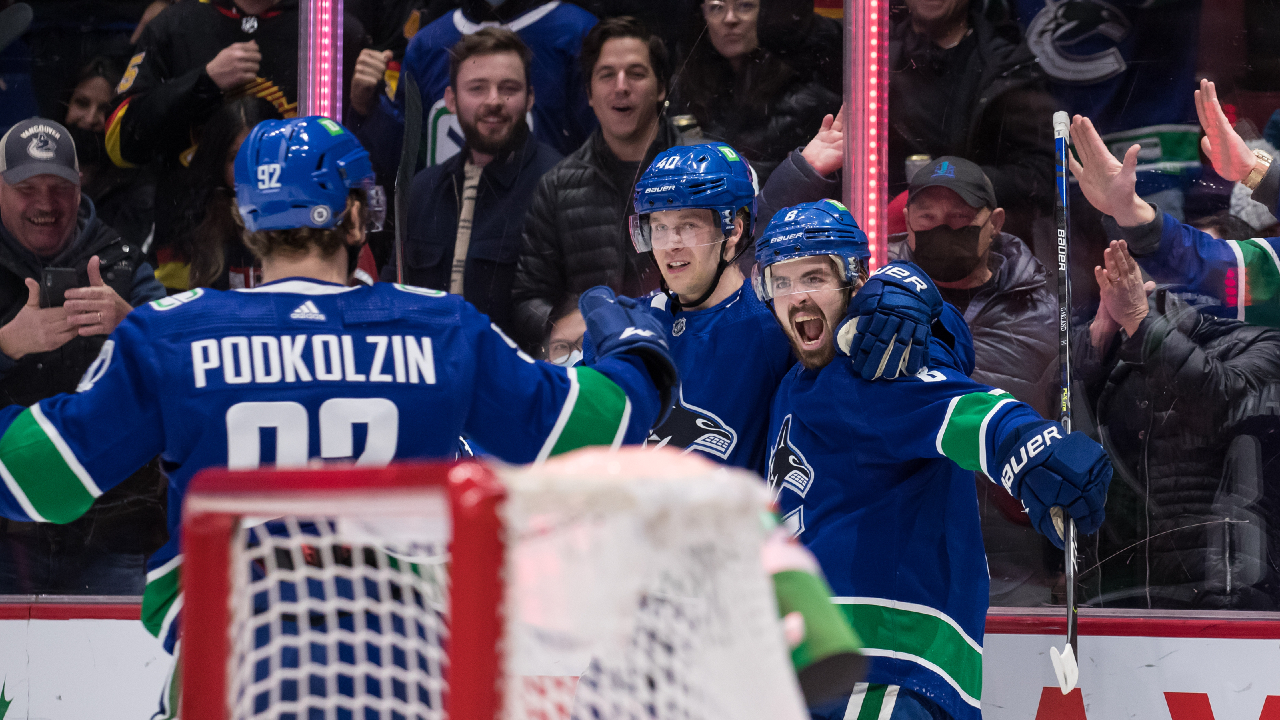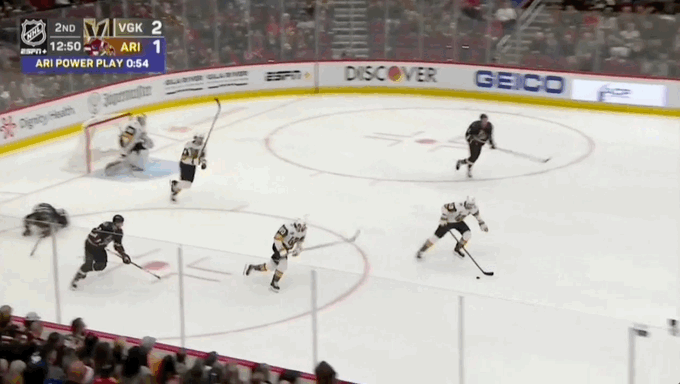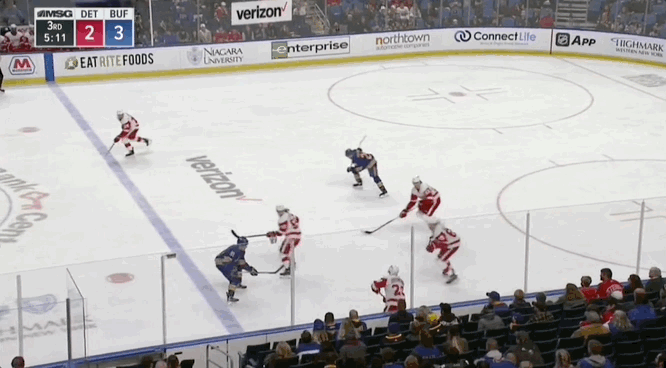
In the spirit of the holidays, we’re looking at what might be on certain teams’ wish lists at this point in the season. Obviously everyone probably is asking for a clean bill of health in general, plus fewer postponed games and complications that come with the current environment. But aside from that, we want to look at some strengths and weaknesses to see what they could want — realistic or unrealistic — moving forward in to 2022.
Vegas Golden Knights: A true penalty kill
We’re taking inspiration from Jeff Marek here, who proposed a ‘true penalty kill’ on the 32 Thoughts podcast. Instead of teams just ‘enduring’ two minutes of shots against, he suggested teams effectively kill a penalty off when they score.
The Golden Knights would benefit from this shift in rules seeing as they’re one of the best at creating offece while on the penalty kill. Their success runs deeper than their league-leading six shorthanded goals for; below the surface, their expected goal rate of 1.37 per 60 minutes shorthanded ranks fourth. That season-wide number includes games where they were without some of their best two-way forwards like Mark Stone and William Karlsson.

While the Golden Knights have been among the league’s best in creating offence while down a player, they haven’t suppressed it as well, conceding 1.99 expected goals against per 60 landing them 29th in that defensive metric. And their goaltending hasn’t been perfect behind that workload either. Both contribute to a 77.5 per cent efficiency on the PK. Some early season struggles and injuries played into that as well — since Stone’s return, which really signified the ‘end’ of their early season injury woes, the team has tightened up in their own end. Still, they wouldn’t have to be as worried about their own zone if they could just end penalties with a shorthanded goal for.
New Jersey Devils: The ability to decline a power play
Whether with the current system for penalty killing, or Marek’s ‘true’ method, the Devils probably wish they could just decline the option to go on the man-advantage. With a true penalty kill, they’d really be in trouble as they’ve allowed a league-leading six shorthanded goals for — five of which have come over the past month while their power play has only delivered four goals for.
It’s not a matter of bad luck for the Devils either while on the power play, it’s a lack of offensive generation. Not only does New Jersey shoot the puck at a low rate, they lack quality chances, too. And they aren’t moving the puck successfully in the offensive zone either. Without that higher rate of passes, they aren’t creating many one-timers — they’ve attempts just 2.1 one-timers per 60, which make up about 23 per cent of their shots. Top teams in the league, to compare, attempt closer to 40 one-timers per 60 on the man-advantage, which compose upwards of 35 per cent of their shots.
Without some legitimate changes to their play on the power play, it’s deflated the Devils at points and cost them close games.
Vancouver Canucks: A time machine
Since Bruce Boudreau took over behind the bench, the Canucks are 6-0-0. Sometimes, teams need to hit rock bottom before they rebound since the only way to go is up. But maybe this was a change that could have come sooner to improve their chances of fighting their way up the Pacific Division standings.
What’s changed on the ice compared to their start? One of their greatest weaknesses pre-coaching change was a lack of offence, even from some of their best players. So far, there have been improvements across the board. Obviously six games is a limited sample and there’s only so many tactical adjustments that can be made in that time. But encouraging players to stick to their offensive instincts and improving the vibes around the team is a start that seems to be working.

Detroit Red Wings: A couple more shots
Tyler Bertuzzi’s vaccination status has been a topic of conversation throughout the season, especially after the forward was sidelined with COVID-19. The biggest issue, on the ice, is that Detroit has to play without him whenever they travel to Canada — and they look a lot different without one of their best offensive generators. Bertuzzi’s one of the best Red Wings at 5-on-5 at shooting (and scoring) from the slot. He also has one of the best passing rates in the offensive zone on the team, and can move the puck to the dangerous areas to set up his linemates, Dylan Larkin and Lucas Raymond.

Without Bertuzzi, they’ve lost their first three games over the border. They’ll miss him again, unless something changes, in six upcoming games in Canada. That’s the potential for 12 points that this team is going to need if they want to maintain their wild card standing.
Seattle Kraken: Replacement level goaltending
The Kraken are one of the stronger defensive teams in the league. They limit their shots against both at 5-on-5 and while shorthanded; in all situations they allow the eighth-lowest rate of shots against, at 56.3 per 60 minutes. They also don’t allow too many attempts from the more dangerous areas of the ice by keeping their opponents out of the slot.
While Seattle doesn’t allow many chances on the rush against, the few that trickle past the team often end up in the back of the net. Overall, their goaltenders just aren’t matching their level of play or responding well to their workloads. In 23 games Philipp Grubauer has now allowed 18 more goals than expected in all situations. Chris Dredger’s let in 4.93 more goals than expected over eight games. Their record would probably look quite a bit different with stronger netminding.

New York Rangers: A redo
The Rangers moved top-six winger Pavel Buchnevich to the St. Louis Blues without a sturdy plan to replace him. Now that most of their options for the right side have failed, they’re missing a key scorer to round out their top lines. While they’re clearly higher in the standings than most expected, sitting third in the division and fifth in the conference with 42 points, there are holes in this team that could prove costly in crucial moments of the season.
While New York’s improved as the season’s progressed, they’re only 20th in their 5-on-5 expected goal creation. The Blues, on the other hand, rank sixth with their 2.75 expected goals for per 60, and Buchnevich has been a key part of it.
Ottawa Senators: Support for goalers
The Senators’ defensive woes make life tough for their goaltenders. No one allows more shots at 5-on-5 (66.2 per 60) than Ottawa, and it’s not just a matter of shot quantity that’s ailing them. They allow the third-highest rate of slot shots against (23.5 per 60), and let opponents drive right to the inner slot. On top of that, they’re below average offensively. So basically, their netminders have to be pretty perfect for this team to have a shot most nights — and they’re not getting much help.
Tampa Bay Lightning: A healing stone
The Lightning managed last year without Nikita Kucherov, but this year, they’re feeling his absence and Brayden Point’s, who has been out since late November. While they have players stepping up — including Ross Colton and Mathieu Joseph, along with Anthony Cirelli — they don’t have the same reinforcements of years past (Yanni Gourde, Blake Coleman, and Tyler Johnson) to help fill the void.
Since Point’s been out of the lineup (and still Kucherov), the Lightning’s 5-on-5 expected goal generation of 2.50 per 60 ranks 20th in the league. And they’ve really been hurting on the power play, creating just 4.69 expected goals for per 60 that ranks 29th over that span. The positive is that the team’s still collecting points along the way, so they’ve been able to hold on without two of their best. But they’re going to need them back to really build on that playoff positioning in the second half of the season.
Data via Sportlogiq
Eight NHL team wish lists: Why the Canucks would like a time machine
Source: Pinas Ko Mahal

0 Mga Komento